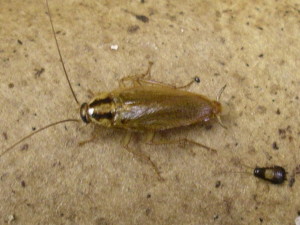 |
Nov 2014 Newsletter | |
German cockroaches
German cockroaches are most commonly found within homes and commercial food establishments, usually in the kitchen. The adults are about ½ inch long, tan and have two dark stripes above the head. The females will carry the egg case protruding from the abdomen until the day before hatching. The nymphs, or baby cockroaches, look similar to the adults, but are smaller and without fully developed wings.
German cockroaches may enter buildings through infested boxes, grocery bags, furniture and dried pet food. They may also enter around loose-fitting doors and windows as wells as through sewer lines, attics, and where pipes penetrate the structure. Cockroaches are associated with filth, but even well-maintained structures can become infested.
German cockroaches are active at night, and are usually only visible during the day if they are disturbed or there is a severe infestation. They like to rest in tight, dark spaces such as under or inside cupboards, behind loose baseboards or in bathrooms. They are omnivores, feeding plant and animal products such as meats, starchy foods, baked goods, leather, book bindings and wallpaper paste.
Inspection is important to any cockroach control program. Identify the type of cockroach and their location. Eliminate indoor hiding places such as paper or cardboard. Sticky traps can help to reduce cockroach populations without the use of chemical. Place traps against walls near cockroach feeding and hiding areas.
Some type of chemical control will be needed to eliminate cockroach infestations. Baits are a combination of toxicants and food attractant. Baits should be placed in areas where cockroaches are known to feed. Residual sprays are available in ready-to-use containers or concentrates that are mixed with water. Sprays are fast and easy to apply. Dust treatments should be used in cracks and crevices, wall voids, under refrigerators or around pipes. Dusts should be applied in a light, even coat that is barely visible. Do not apply dust or residual sprays to areas that have bait.
For more information or help with identification, contact Wizzie Brown, Texas A&M AgriLife Extension Service Program Specialist at 512.854.9600.

